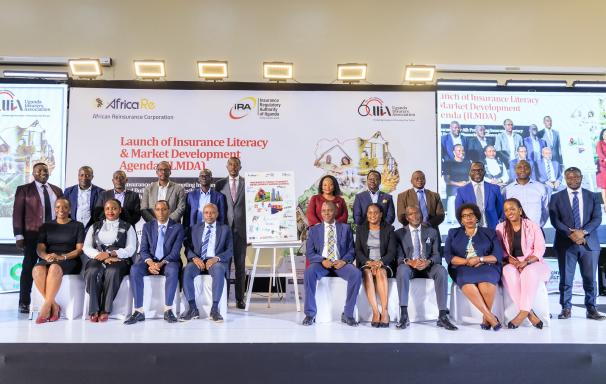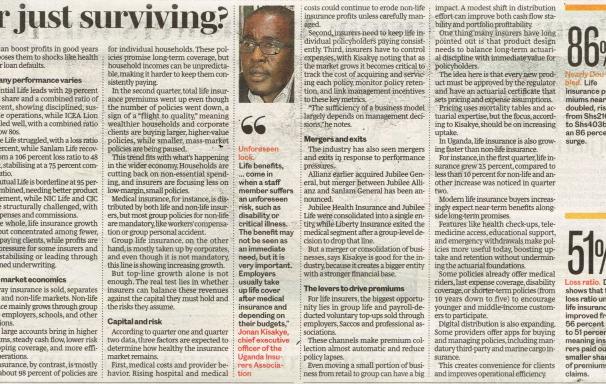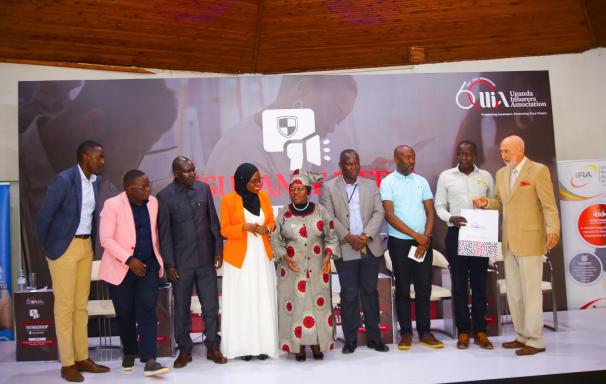Background
The confirmation of commercial oil and gas resources in Uganda in 2006 has since been a source of both pride and high expectation for many Ugandans. More was the announcement of the Final Investment Decision (FID) for the Tilenga, Kingfisher and EACOP projects in February 2022. This has contributed a lot of positive growth and built zeal in the sector players to hasten their operations. Insurance is a vital aspect in Uganda’s Oil and gas sector which will require some form of cover against unforeseen risks for investors, workers and contractors at all levels. The risks in the oil and gas industry are enormous, and a single insurer may not be able to cover them; thus, the insurance industry formed what is known as the Insurance Consortium.
2.0 Introduction.
The visit to the oil sites was opened by Mr. Didas Muhumuza, Senior Stakeholder Management Officer at Petroleum Authority of Uganda (PAU), who gave opening remarks and the status of the current developments of Uganda’s nascent oil and gas developments. In his remarks he shared about the role of Petroleum Authority Uganda (PAU) as the regulator for upstream and midstream while Uganda National Oil Company (UNOC) is the government’s commercial arm in the oil and gas sector.
The narration started with East African Crude Oil Pipeline (EACOP) starting point of construction from Kabaale International Airport. The purpose of the pipeline is to transport Uganda’s oil to both regional and international markets. The pipeline will cross a minimum of 10 districts as it connects to the port of Tanga, Tanzania.
We are at the stage of the process where many involved stakeholders need risk mitigation services in this sector. Some of the highlights are the East African Crude Oil Pipeline (EACOP), aviation related activities at the Kabaale International Airport, the Refinery, and most of the operations at CNOOC’s Kingfisher Development Area and the Tilenga Project operated by Total Energies E&P.
3.0 SITES VISITED.
3.1 The Kingfisher Project.
The briefing on the latest activities from CNOOC’s Bugoma Drilling Camp in Kingfisher was given by Mr. Zack Lubega, Head, of Corporate Affairs. He welcomed the Insurance delegation and encouraged them to ask as many questions as they could to have a conversation that is wholistic. He added that delegation site visits are vital for key sector players to give them clear insight into what’s happening in the sector as the development stage takes shape. Key insights shared was the nature of the camp and how the developments will shape up. Some of the key features at the camp was the number of Oil pads they handle and how the facility will tap into the Central Processing Facility. Developments similar to these have a major impact to the citizens in the community that can be positive or negative. CNOOC continues to prioritise and focus on ensuring that the community and surrounding areas benefit from the project. This is being done through thorough resettlement plans for the Project affected persons, improved community skilling as well as ring fencing some services to be provided by the locals not Nationals to ensure community involvement and development.
3.2 Kabaale International Airport.
This is another key major facility that was contracted to SBC after government acquisition of the land measuring about 5 square miles. The location of the airport is the hub of the Industrial park that will house, refinery, crude oil and products storage, transmission hub, logistics warehousing, offices, petrochemical industries and associated facilities among others. The Industrial areas will house the Refinery, an export hub as well as medium and light industries. The airport is hoped to be completed by the next half of 2023.
3.3 The Tilenga Project.
The Tilenga project located in the Lake Albert Basin, Republic of Uganda, and is the centrepiece of oil projects projected to bring investments of over $10 billion to Uganda and Tanzania. The project houses over 426 wells (about 200 water injector wells) which are planned to be drilled on 31 well-pads. The Tilenga Project is planning to develop nine (9) fields that include; Jobi-Rii, Ngiri, Gunya, Kasemene, Wahrindi, Kigogole, Nsoga, Ngege, and Ngara. We visited Kasemene and we were taken through the history of Oil discoveries in Uganda, the process of oil discoveries till exploration, the timelines involved as well as the key challenges which guided on our involvement to handle risk across the value chain.
3.4 Tilenga Industrial Area.
Currently the project has two major contractors that include; Mota Engil Uganda and McDermott. Mota-Engil is handling the earth works for site preparation for the establishment of the Tilenga Industrial Park.
The second Contractor MMcDermott and its sub-contractors on site are providing; engineering, procurement, construction and commissioning (EPCC) services for the development of the onshore oil field that will generate up to 200,000 barrels per day. The Tilenga project currently consists of 31 well pads connected to a Central Processing Facility (CPF) via buried flowlines. Some of the key works include; bush clearing, fencing, construction of drainage channels, internal roads on site among others. For the relevancy of Insurance, a number of other service contractors will be hired to handle these two areas and there is need to have a critical analysis of the areas that need Insurance coverage so as to engage the providers of the services.
3.5 EnviroServ Waste Management Facility.
Wastes generated from crude oil and natural gas exploration and production have potential impact on public health and the environment, including potential impacts arising from improper management of wastes from exploration and production activities.
Thus, the management of waste in our own country is not unique. EnviroServ Waste Management and Disposal Facility located in Nyamasoga Village, Bugahya County in Hoima District plays a critical role. The facility commissioned in 2015 has four major components such as laboratory to test incoming wastes; a sewage treatment plant; a landfill that is engineered to international design standards; and a contaminated stormwater dam to contain run-off from the site. The site only manages hazardous waste to ensure proper disposal with minimal or zero impact to persons and society.
3.6 Resettlement of Project Affected Persons (PAPs).
The Tilenga project also affected over 4,000 persons in different communities. About 88% have been compensated and relocated. The UIA team visited some of the homes comprising of a two bedroom, living room and an outside modern kitchen in Buliisa.
Total Energies E&P aims at improving the livelihood of the community persons and as such the nature of construction are the modern facilities to ensure improved welfare in the people leaving in these communities.
3.7 Avogera Health Centre III.
Total Energies E&P Uganda continues to support the Oil region with health facilities. This is aimed at ensuring a healthy and vibrant community not only to serve but also to enjoy a decent lifestyle. Total Energies E&P Uganda handed over one the many health facilities known as Avogera Health Centre III (out-patient department) to Buliisa District Local Government. The facility was reconstructed and equipped as part of the Company’s livelihood restoration activities under the Tilenga Project Resettlement Action Plan.
4.0 Conclusion.
Visiting of the Oil and Gas region was an all-inclusive eye opener for the many Insurers that visited to understand the opportunities spread in these sectors and to ensure their potential maximisation. The Ugandan team was joined by a team of Insurers of Tanzania to have a wholistic understanding of the project from start to end. Since the project has two major countries involved and that is Uganda and Tanzania this trip created a lot of synergies between the players.
Compiled by;
Kalule Gava Ibrahim.
Public Relations & Market Development.




